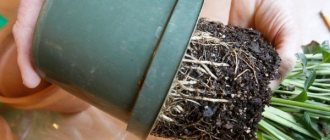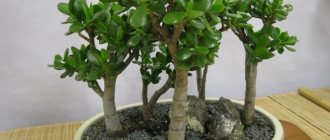Description of Calathea crocata
In the wild, this representative of the Marantaceae family grows in South America. We grow it as a houseplant. This variety of calathea is distinguished by beautiful variegated leaves, with seemingly striated lines.
She looks like an artificial flower. The leaf blades are large, oval in shape, 5-6 of them appear annually. This perennial plant is capable of flowering . It can grow up to a meter in height in an apartment, but more often its height does not exceed 40-50 cm.
Description of the plant and photo
Calathea saffron (Calathea crocata) grows along the Amazon coast. The tropics of the USA are considered the birthplace of the flower. The plant belongs to the genus Calathea . It is a perennial with a well-developed root system. Refers to herbaceous plants.
It has a shortened stem, from which grows a large rosette with elongated leaves on petioles. The diameter and height of the rosette reach one and a half meters.
The leaf blades are large, ovoid in shape . They can reach 25-35 cm in length. They are very stretched near the central vein. This creates a ribbed surface. The front side is emerald green, the back side is purple .
Flowering occurs in January-March. Tubular-shaped flowers . They have burgundy tips. Collected in small thyroid inflorescences.
The bracts are hidden, orange in color. Peduncles are elongated. They grow from the center of leaf rosettes. Each flower blooms for more than 15 days.
More details about the Calathea Saffron plant can be found in the photo below:
Home care
This flowering plant needs proper care. This is a rather capricious flower, which, if there are errors in its maintenance, will immediately lose its decorative appeal .
Important! Caring for such a specimen involves not only watering and fertilizing, but also proper adjustment of daylight hours.
Lighting
The plant needs long daylight hours (8-10 hours). It is better to choose a bright place for the flower, but bright and direct sunlight may cause burns on the foliage .
Therefore, it is preferable to grow the flower on eastern or western windowsills.
Watering
Calathea saffron is demanding on the humidity of the surrounding space. If this parameter is low, not only will it not bloom, but its leaves will dry out, curl, and fall off .
Every other day you will have to spray the plant, wipe its foliage with a wet sponge, and place the pot on a tray filled with wet pebbles.
Note! In summer, the plant is watered once every 2-3 days; in winter, once a week is enough. It is important to ensure that there is no overflow. Water for irrigation should be at room temperature or slightly warmer.
Top dressing
In the warm season (from mid-spring to autumn), the flower must be fertilized every two weeks; in cold weather, fertilizing is applied once a month . For saffron calathea, you can purchase any universal fertilizers aimed at flowering species.
Temperature
For a heat-loving plant, the optimal conditions are +18...+25 degrees. However, it cannot be placed on a window that is opened for ventilation, since the culture does not tolerate drafts .
In winter, calathea can exist at low temperatures (8-10 degrees), but it needs to be watered less often.
How to make calathea bloom?
Calathea crocata, if provided with ideal conditions, blooms in the middle of winter with unusually shaped, fragrant flowers of orange or yellowish color .
For a plant to bloom, it needs a preparatory period. In mid-autumn, the flower's daylight hours are reduced to 10 hours .
To do this, after 18.00 and until the morning, the specimen is covered with a black (dark) bag, always large, so that the polyethylene does not come into contact with the foliage. Keep the indoor plant this way until mid-winter , until it begins to bud.
Calathea crocata
One of the most decorative types of cataleas grown at home. Not only does the variety have amazingly beautiful wavy foliage in a deep purple-green hue. A striking feature of this species is its large, numerous inflorescences, which are unusual for a calathea in an orange-yellow hue. It is thanks to the color, close to the color of saffron, that Calathea Crocata received its second name.
Many gardeners know this elegant species as saffron calathea. Compared to closely related species, this plant is quite compact and will not take up much space even on an indoor windowsill. But the plant’s disposition is not very flexible; flowering and stable growth of dark foliage can only be achieved if all the requirements for caring for this guest from the distant tropics are met.
The photo of a flower of this species clearly shows how bright the orange inflorescences appear against the background of almost black foliage. The decorative deciduous crop responds well to fertilizing, does not tolerate direct sunlight and tolerates replanting well, which gives it the opportunity to increase green mass.
Reproduction of calathea at home
First of all, you need to take care of suitable soil. It is prepared according to the following calculation: for every 2 volumes of leaf soil, take 1 volume of river sand and peat , and also add a little crushed bark or coal.
The soil should be light and breathable. Drainage is provided at the bottom of the pots .
The flower is propagated in several ways:
- Dividing the bush. This is the simplest option. During spring replanting, an adult plant is divided into several parts so that each piece has several formed leaves. Each division is planted in a separate pot . At first, the separated parts can be kept in a greenhouse for better rooting.
- Leaf and cuttings. This is a more complex method. Necessary take a leaf from an adult plant or a cutting and plant it in moist soil, keep it in a greenhouse until rooting.
- Growing from seeds. The most complex method, suitable for the most experienced gardeners. It is better to grow the plant from purchased seeds. They are first treated with a weak solution of potassium permanganate (1 g per 100 ml of water), then sown in a mixture of earth and sand in a ratio of 2:1 . Keep under film until the first leaves appear.
Young calathea seedlings are even more capricious than an adult plant . They are very sensitive to temperature changes.
This video explains how to transplant and propagate calathea from cuttings.
Transplantation and propagation
Calathea crocata has an undeveloped and superficial root system, so it is not necessary to plant it in a deep container. The main requirement for a pot is sufficient width so that the rhizome feels free.
It is necessary to replant a young flower annually, usually in the spring. After reaching 3-4 years, it is replanted as needed, when the rhizome becomes crowded.
For the next transplant you need to choose a wider pot. A layer of drainage is placed at its bottom, and soil is placed on top. You can take special soil for plants of the arrowroot family or for Saintpaulias.
You can make your own soil for saffron calathea by mixing 6 parts of soil with humus, 3 parts of peat and 2 parts of river sand. If you take soil for Saintpaulia, then you should also add some sand to it. Under natural conditions, Calathea crocata reproduces by seeds or vegetatively.
Reproduction of ornamental varieties of plants is most often carried out by dividing the root. After dividing it into parts, you should treat the cut areas with an activated carbon solution to prevent rotting or infection. The flower is propagated during the next transplant.
Benefits and harms
The plant creates a healthy atmosphere indoors. Calathea leaves clean the air from dust, smoke and other microparticles, increasing the oxygen content .
Gardeners choose this plant for its properties:
- this is the only flowering representative among the Kalathas;
- beautiful flowers and leaves make the plant very attractive ; it is used to decorate various rooms;
- flowers appear in winter, they are orange, reminiscent of summer;
- buds bloom for a long time (1.5-2 months).
But, like any plant, Calathea crocata has a number of disadvantages. The aroma of blooming flowers is quite specific; not everyone likes it .
The plant is capricious, especially demanding of air humidity. In order for Calathea to feel good and regularly delight with abundant flowering, it needs to regulate daylight hours .
Attention. Calathea crocata should not be grown by those who are just starting out in floriculture. It is more suitable for experienced florists.
Diseases and pests
Calathea crocata is often affected by spider mites. It is not so easy to notice, so the plant must be carefully inspected regularly. For preventative purposes, wash it periodically with soap . In case of infection, treat with insecticides. Another pest that affects Calathea is scale insects and thrips. To combat them, Confidor and Fitoverm will be useful.
Also, one of the most common problems that gardeners face when growing this plant is the leaves drying out or darkening (described in detail here). This happens from improper watering and low humidity . This also happens if water that is too hard and contains a lot of calcium is used.
Note! When discolored spots appear on the leaves, the plates dry out and curl - these are signs of sunburn. The plant must be moved to a dark place. This crop can curl its leaves even at low temperatures, as well as due to drafts.
Although Calathea crocata is a capricious plant, it fully compensates for this deficiency with beautiful, abundant flowering and decorative leaves . And any skills are acquired with experience. Place such a beauty on your windowsill, and it will definitely delight you with its appearance.
This video talks about calathea and shows how you can try to save a diseased plant.
Pests of indoor calathea
Often the manifestations that calathea owners mistake for leaf diseases are actually symptoms that the plant has pests.
So, calathea pests:
- Spider mite.
Symptoms: a characteristic white coating, reminiscent of a thin cobweb, and white dots also appear on the indoor flower.
Why it appeared: Spider mites appear if the climate around them is dry enough. Therefore, the best prevention against it is frequent wet cleaning around the calathea and spraying.
What to do: if the lesion is small, then simply remove the leaves affected by the cobwebs. If the flower is significantly infected, there is a lot of plaque and insects, then you will need to treat the plant with several types of insecticides (the break between treatments is 10 days so that the chemicals do not negatively affect the calathea organism itself) and replant, because spider mites can lay larvae in the soil.
- Shield.
Symptoms: characteristic waxy spots on the leaves, and then, when the scale insect drinks enough juice, the plant withers, dries out, and becomes covered with brown spots.
What to do: wash off all insects from the calathea under a hot shower or using cotton pads generously soaked in a thick solution of laundry soap. Then start treating with insecticides.
The scale insect is dangerous because it easily adapts to chemicals thanks to its natural protection - a shield on its back - so you will have to arm yourself with several types of drugs at once, and also use cross-treatment with several of them at once.
- Thrips.
Symptoms: White spots on the leaves that will eventually dry out and become a hole.
What to do: treat with insecticides, replant the plant, reduce watering, since thrips often go hand in hand with root rot.
Why they appeared: unlike other pests, thrips prefer a humid climate, so they usually appear in waterlogged soil. Replanting is required: the soil dries out slowly, so thrips may appear again, even if you treated the calathea with medicines for them, because the conditions are favorable.
Prevention: sufficient (because calathea loves moisture), but not excessive watering.
What else you need to know about pests of indoor flowers:
- Most often, pests prefer dry climates, where they reproduce most actively. This is good news for you, because the very rules for keeping calathea mean that it needs to be moistened regularly; this is a flower that simply loves moisture. So, if you take care of the flower, dryness will not cause pests.
But it is still necessary to periodically inspect the calathea, look under the lower leaves (this is where insects often nest), especially when winter comes, the heating season begins, and the air becomes dry and hot from the radiators.
- Often pests are introduced simply because of bad luck. For example, they brought it from the street on shoes, or an insect jumped off a pet, or simply flew into a window. Therefore, do not blame yourself for “not looking”, this can happen to anyone. Calathea diseases often begin with improper care, but pests are pure luck.
- Pests are dangerous for two reasons: firstly, they are easy to miss and come to your senses when the insects have already multiplied so much that the plant cannot be saved, and secondly, they are very tenacious and easily adapt to the environment.
From here there are two conclusions: firstly, do not forget to periodically inspect your calathea in order to notice insects in time, and secondly, if they do appear, purchase several types of pest control medicines at once (usually fungicides and insecticides), because after the first they will not be lost during processing.











